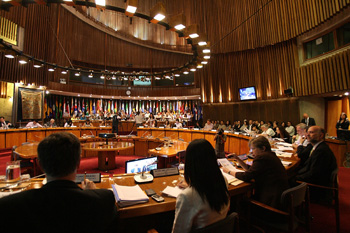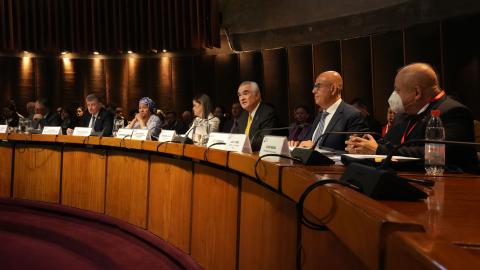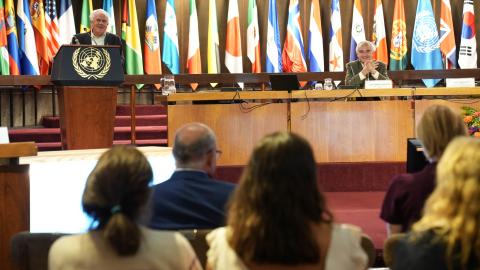Speech
(30 November 2010) Poverty and extreme poverty will fall in Latin America in 2010, thanks to the robust economic recovery in most of the region's countries, according to an ECLAC report published today.
The Social Panorama of Latin America 2010, presented in Santiago, Chile, by the ECLAC Executive Secretary, Alicia Bárcena, predicts that poverty and extreme poverty will be 1.0 percentage points and 0.4 percentage points lower, respectively, than in 2009, which was when the region bore the brunt of the international financial crisis.
Therefore, 32.1% of the population of Latin America is expected to remain in poverty and 12.9% in extreme poverty in 2010 (which represents 180 million people in total, including 72 million people in extreme poverty), which is similar to the levels observed in 2008.
The ECLAC report emphasizes that, despite the major repercussions that the international crisis has had in the region, in 2009 poverty rose by just one tenth of a percentage point (from 33.0% to 33.1%). As a result, it is hoped that the region is returning to the downward trend in poverty that began in 2003.
According to Ms. Bárcena, "the region's countries are showing resilience in terms of social variables that has not been seen in previous crises".
In most of the 9 countries considered in this study poverty decreased. For instance, between 2008 and 2009, poverty fell in Brasil (from 25.8% to 24.9%), Paraguay (from 58.2% to 56%), Dominican Republic (from 44.3% to 41.1%) and Uruguay (from 14% to 10.7%).
The poverty percentage also decreased between 2006 and 2009 in Argentina (from 21% to 11.3%) and Chile (from 13.7% to 11.5%).
In contrast, poverty rose between 2008 and 2009 in Costa Rica (from 16.4% to 18.9%) and Ecuador (from 39% to 40.2%). In Mexico, poverty also increased (from 31.7% in 2006 to 34.8% in 2008).
The document adds that inequality in the region has been reduced thanks to the rise in the labour income of poor households and public transfers aimed at reducing the impact of the crisis. Income distribution remained stable in 2009, such that the overall situation for the past seven years remains positive for most countries.
In this 2010 edition, the Social Panorama of Latin America also provides an analysis of how inequality is reproduced throughout people's life cycles, especially between birth and the age of 29.
According to ECLAC, more equal societies tend to be those that give more backing to educational achievement and learning for all social groups. The report stresses that education is one of the main factors that can undo inequalities of origin (family or territory based) and provide equal opportunities for well-being and productivity for society as a whole.
On average, 49% of men and 55% of women aged 20-24 have completed secondary education, while in rural areas the figures are 26% of men and 31% of women (and then 22% and 20%, respectively, among indigenous people of that age). According to ECLAC, this is a striking demonstration of the intergenerational reproduction of exclusion and inequality.
"To close inequality gaps in the region, it is important for governments to adopt a generational approach to economics to provide a comprehensive and long-term view", stated Alicia Bárcena.
Although Latin America witnessed a major reduction in child poverty between 2002 and 2009, poverty continues to affect children and adolescents more than other sectors of society.
The documents shows that the persistent inequality in countries is due to the high concentration of poverty in the early stages of life, the burden of family transfers for children and the greater burden of public transfers to adult generations, combined with the low effectiveness of education systems to undo inequalities of origin.
The document adds that, in Latin America, governments have a limited role in financing the consumption of children and young people (only 21%), whereas in developed economies the State shares this role with families (by providing 45%). It is therefore vital to increase public transfers for childhood and adolescence.
The good news is that public social spending soared between 1990 and 2008, both in absolute terms (from 445 dollars to 880 dollars per person) and relative terms (from 12.3% to 18.4% of GDP). This is vital to help narrow the gaps in various stages of the life cycle.
Following the recent international crisis, governments adopted relevant policies to avoid a more negative impact on poverty and employment. Policies aimed specifically at combating poverty include the expansion of conditional transfer programmes, which benefit 20% of the population in Latin America and the Caribbean who are clearly vulnerable.
To combat the intergenerational reproduction of inequality and exclusion in the formative years, ECLAC proposes three types of measures throughout the life cycle: a scheme of cash transfers to households with children aged 0 to 14 to improve the opportunities for families to have an appropriate environment for the socialization of children (nutrition, housing, clothing); financing of policies to cover the costs of incorporating those who are not covered by educational and care services (0 to 17 years); and lastly, another series of cash transfers related to employment and training services targeting young people in the process of joining adult life (15 to 24 years).
To introduce these measures, the report presents a simulation of a conditional transfer system for the various countries in the region in terms of costs (as a percentage of GDP), so that the vulnerable population (those nearly in poverty, the poor and the extremely poor) can be supported in terms of nutrition, health, early stimulation and access to pre-school education and support to progress through education and complete secondary school.
Results show that very significant gains would be made in terms of reducing poverty (by up to 25% or 30%) in countries such as Guatemala and Nicaragua, while in more socially developed countries (such as Uruguay and Chile), the reduction would be even larger (reducing poverty by almost two thirds).
- See figure. Latin America: poverty and extreme poverty, 1980-2010
- See presentation by ECLAC Executive Secretary, Alicia Bárcena
An information documents on the Social Panorama of Latin America 2010 will be available on the ECLAC website on Tuesday 30 November from 12:00 p.m.
For any queries, please contact the ECLAC Public Information and Web Services Section.
E-mail: dpisantiago@cepal.org; telephone: (56 2) 210 2040.


